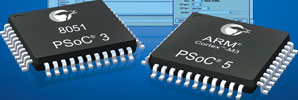

Cypress Semiconductor announced two new architectures in its PSoC programmable system-on-chip platform that increase performance and extend the programmable analog and digital embedded design platform, delivering integration and flexibility across 8-, 16- and 32-bit applications.
This new platform is powered by the PSoC Creator Integrated Development Environment, which introduces a schematic-based design capture along with fully tested, pre-packaged analog and digital peripherals customisable through wizards and APIs to meet specific design requirements.
The programmable analog and digital peripherals in PSoC 3 and PSoC 5, along with new high performance 8-bit and 32-bit MCU subsystems, enable new capabilities such as motor control, intelligent power supply and battery management, human interfaces such as CapSense touch sensing, LCD segment display, graphics control, as well as audio/voice processing, communication protocols and more. These new capabilities expand the markets that PSoC can address, including industrial, medical, automotive, communications and consumer equipment.
The new PSoC 3 and PSoC 5 architectures include high-precision, programmable analog resources that can be configured as ADCs, DACs, TIAs, mixers, PGAs, op amps and more. They also include enhanced programmable-logic based digital resources that can be configured as 8-, 16-, 24- and 32-bit timers, counters and PWMs, as well as more advanced digital peripherals such as cyclic redundancy check (CRC), pseudo random sequence (PRS) generators and quadrature decoders. Designers have the ability to customise this digital system through general purpose PLD-based logic available in PSoC 3 and PSoC 5. The new architectures also support a wide range of communications interfaces, including Full-Speed USB, I²C, SPI, UART, CAN, LIN and I²S.
The PSoC 3 architecture is based on a new, high-performance 8-bit 8051 processor with up to 33 MIPS, while the PSoC 5 architecture includes a powerful 32-bit ARM Cortex-M3 processor with up to 100 DMIPS. Both architectures meet the demands of low-power applications by delivering a wide voltage range from 5,5 V down to 0,5 V, along with low 200 nA hibernate current. They provide a seamless platform from 8- to 32-bit architectures with pin and API compatibility between PSoC 3 and PSoC 5, along with programmable routing, allowing any signal, whether analog or digital, to be routed to any general-purpose I/O to ease circuit board layout. This capability includes the ability to route LCD segment display and CapSense signals to any GPIO pin.
A PSoC development kit offers support for the entire PSoC line, including PSoC 1, PSoC 3 and PSoC 5 devices. The kit contains a main PSoC development board and processor module boards for the different architectures. Sample projects are also provided.
For more information contact Marian Ledgerwood, Future Electronics, +27 (0)21 421 8292, [email protected], www.futureelectronics.com
| Tel: | +27 21 421 8292 |
| Email: | [email protected] |
| www: | www.futureelectronics.com |
| Articles: | More information and articles about Future Electronics |

© Technews Publishing (Pty) Ltd | All Rights Reserved